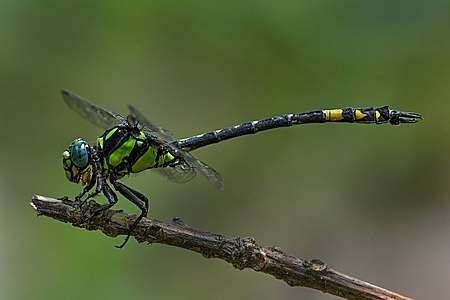Megalogomphus hannyngtoni
Megalogomphus hannyngtoni,[2] is a species of dragonfly in the family Gomphidae. It is known only from the Western Ghats of India.[1][3]
| Megalogomphus hannyngtoni | |
|---|---|
 | |
| Male | |
| Scientific classification | |
| Kingdom: | |
| Phylum: | |
| Class: | |
| Order: | |
| Family: | |
| Genus: | Megalogomphus |
| Species: | M. hannyngtoni |
| Binomial name | |
| Megalogomphus hannyngtoni (Fraser, 1923) | |
| Synonyms | |
|
Heterogomphus hannyngtoni Fraser, 1923 | |
Description and habitat
It is a large dragonfly with bottle-green eyes. Its thorax is black; marked with bright greenish-yellow stripes. Abdomen is black, marked with bright citron-yellow. Segment 1 has a small apical dorsal triangle and the whole of the sides. Segment 2 has a dorsal and a lateral stripe, broad at the base. Segment 3 has a dorsal stripe and a lateral wedge-shaped spot at the base. Segments 4 and 5 have a chain of three dorsal spots. Segment 6 has a single baso-dorsal spo. Segment 7 has more than the basal half yellow. Segments 8 and 9 have small lateral basal triangular spots. Segment 10 is entirely black. Anal appendages are black.[4]
This species is found in forested mountain streams and patrol the banks. They usually perch on overhanging twigs and rarely on rocks in hill streams. It breeds in fast flowing hill streams.[4][5]
See also
- List of odonates of India
- List of odonata of Kerala
References
- Subramanian, K.A. (2011). "Megalogomphus hannyngtoni". IUCN Red List of Threatened Species. 2011: e.T175188A7119228.
- "World Odonata List". Slater Museum of Natural History. Retrieved 2018-10-02.
- K.A., Subramanian; K.G., Emiliyamma; R., Babu; C., Radhakrishnan; S.S., Talmale (2018). Atlas of Odonata (Insecta) of the Western Ghats, India. Zoological Survey of India. pp. 232–233. ISBN 9788181714954.
- C FC Lt. Fraser (1934). The Fauna of British India, including Ceylon and Burma, Odonata Vol. II. Red Lion Court, Fleet Street, London: Taylor and Francis. pp. 296-298.
- C FC Lt. Fraser (1924). A Survey of the Odonate (Dragonfly) Fauna of Western India and Descriptions of Thirty New Species (PDF). pp. 478–479.
